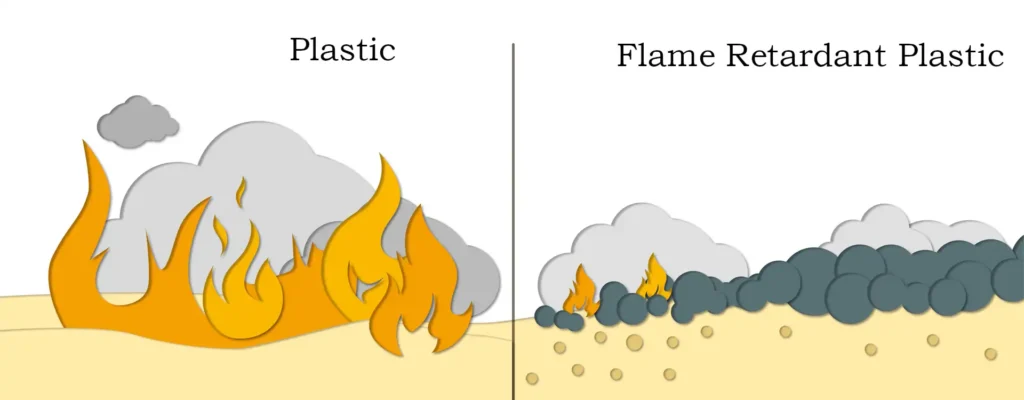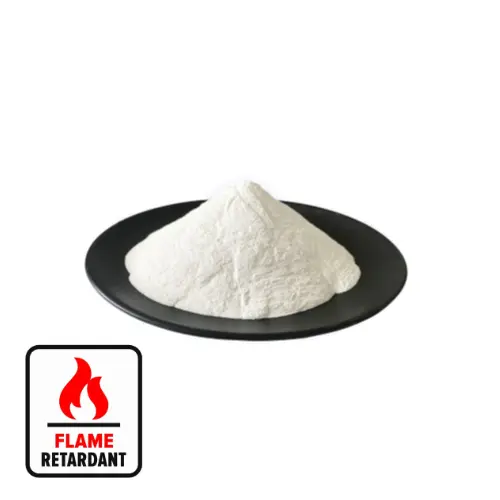In today’s society, polymer synthesis technology is developing rapidly, and materials such as plastics, rubber and synthetic fibers are widely used in daily life. However, all polymers have defects, due to its own composition by a chain of carbon and hydrogen atoms, resulting in compounds that are flammable, which can lead to the rapid spread of fire.

When a certain amount of flame retardant is added to the material, the flame retardant properties of the material will be improved accordingly, but often the mechanical or other properties of the material will be affected, and sometimes it will bring inconvenience to the processing. Therefore, in order to maintain the comprehensive performance of flame retardant composites, the comprehensive performance of flame retardants should be considered.
Advantage
Magnesium hydroxide has many advantages as a flame retardant material:

(1) The decomposition temperature of magnesium hydroxide is high, and the ignition point is higher than aluminum hydroxide, which improves the heating temperature of polymer materials;
(2) MgO generated after combustion and dehydration is a refractory material and is an alkaline oxide that absorbs acidic gases;
(3) Strong heat-absorbing capacity and high flame-retardant efficiency;
(4) Low cost and easy to process in different polymer materials.
In recent years, magnesium hydroxide as a kind of green flame retardant, the application amount is very large.
Preparation of magnesium hydroxide
Preparation of magnesium hydroxide most need to control two aspects:
(1) filtration performance, if the magnesium hydroxide slurry settling performance is poor, it will affect the washing and separation operation process, resulting in the prolongation of the synthesis cycle of magnesium hydroxide, and it will affect the yield of magnesium hydroxide; (2) control of morphology, because magnesium hydroxide with a regular morphology of the flame retardant effect is better, and therefore need to use the appropriate production methods and process conditions in order to meet the requirements.
The main production process of magnesium hydroxide has direct precipitation method, magnesium-containing ore grinding method, magnesium oxide hydration method and so on.
Direct precipitation method
At present, there are many methods to synthesize magnesium hydroxide, among which the most used method is the precipitation method, due to its low price and simple operation, easy to control the crystal morphology. In the precipitation method, mainly salt solution precipitation, usually using strong bases, such as ammonia or sodium hydroxide, magnesium salt in the most widely used is magnesium chloride, magnesium sulfate and magnesium nitrate, organic magnesium salt magnesium acetate is also occasionally used.
The preparation of magnesium hydroxide by ammonia in the direct precipitation method is divided into one-step method and continuous precipitation method, and the continuous precipitation method realizes the recycling of resources, reduces the production cost, and ensures the quality of the product.
Hydrothermal method
Hydrothermal reaction can effectively control the shape and size of magnesium hydroxide, the nature of the product mainly depends on the type of precursor magnesium salt, solvent and the control of the reaction process temperature; the shape of the product mainly depends on the pH of the solution and the temperature of the reaction. The morphology of the synthesized magnesium hydroxide is nanofloral, acicular, flaky and spherical by adjusting the pH.
The advantage of hydrothermal synthesis is that the specific surface area of magnesium hydroxide is greater than 100 m2/g. The disadvantage is that high temperature and pressure are used industrially and the cost is high.
Acoustochemical synthesis
Acoustochemical methods use ultrasonic waves in the range of 20 kHz-10 MHz to initiate the formation and collapse of microcells and produce active sites at high temperature and pressure. In contrast to conventional methods, this method occurs under extreme conditions and is able to greatly increase the rate of the reaction, producing small crystals with a more homogeneous morphology. Sonochemical synthesis is characterized by the fact that different structural types of materials can be produced by changing the reaction medium.
Sol-gel method
The sol-gel method involves mixing highly reactive metal compounds as precursors in the liquid phase, which are hydrolyzed and condensed to produce metal hydroxides. A stable, transparent sol is formed, which is slowly polymerized by aging to form a network structure and loses solvent during the reaction process to form a gel. The gel undergoes subsequent drying and sintering to prepare nanomaterials.
The process of reaction of this method is the precursor dispersion dissolution, hydrolysis to generate monomers, polymerization occurs, the generation of sol, after drying and heat treatment and other processes, the preparation of nano-magnesium hydroxide materials.
The use of magnesium hydroxide
Magnesium hydroxide has a wide range of uses, the flame retardant field and the environmental protection field are the main fields of magnesium hydroxide application. In addition, due to the high activity of magnesium hydroxide slurry, adsorption performance is good, convenient and controllable adjustment, magnesium hydroxide can be used as a neutralizing agent for acidic waste liquids and sulfur-rich oxides treatment, heavy metal removal, improve the acidity of the soil, but also as an antacid agent used in pharmacy, fertilizer additives and so on.
Modification of magnesium hydroxide
At present, the commonly used surface modification methods of magnesium hydroxide are superfine method, surface chemical coating and microencapsulation.
1, chemical coating modification of magnesium hydroxide
Chemical coating modification is the surface modification of magnesium hydroxide surface modification of the most used modification methods, which can be selected from a variety of modifiers, such as surfactants, coupling agents, hyperdispersants and modifiers compounding and so on.
(1) Surfactant
Because the surface of magnesium hydroxide has a high positive charge, so generally use anionic surfactants, such as stearic acid, sodium stearate, zinc stearate, sodium oleate and sodium dodecyl sulfonate and so on.
(2) Coupling agent
Coupling agent treatment is currently the most commonly used modification method for surface modification of magnesium hydroxide, of which the most commonly used is silane coupling agent.
(3) Modifier compounding
Different types of modifier compounding, can give full play to their respective advantages, the formation of complementary, in practice, showing good modification effect, has a good development prospects.
2、Magnesium hydroxide polymerization graft coating
Polymerization grafting modification can significantly enhance the dispersion and compatibility of magnesium hydroxide in the polymer, mechanical properties have also been improved.
3、Magnesium hydroxide encapsulation modification
Encapsulation of modified magnesium hydroxide, not only to improve its compatibility with the polymer matrix, but also to improve the mechanical properties of composite materials, thermal stability and flame retardant properties, become a hot spot in the field of flame retardant research. The disadvantage is the difficulty of encapsulation and the need to strictly control the experimental conditions.

